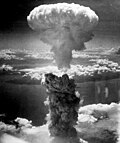
The Manhattan Project was a research and development undertaking during World War II that produced the first nuclear weapons. It was led by the United States with the support of the United Kingdom and Canada. From 1942 to 1946, the project was under the direction of Major General Leslie Groves of the U.S. Army Corps of Engineers. Nuclear physicist Robert Oppenheimer was the director of the Los Alamos Laboratory that designed the actual bombs. The Army component of the project was designated the Manhattan District as its first headquarters were in Manhattan; the placename gradually superseded the official codename, Development of Substitute Materials, for the entire project. Along the way, the project absorbed its earlier British counterpart, Tube Alloys. The Manhattan Project began modestly in 1939, but grew to employ nearly 130,000 people at its peak and cost nearly US$2 billion. Over 90 percent of the cost was for building factories and to produce fissile material, with less than 10 percent for development and production of the weapons. Research and production took place at more than thirty sites across the United States, the United Kingdom, and Canada.

Oak Ridge National Laboratory (ORNL) is a federally funded research and development center in Oak Ridge, Tennessee, United States. Founded in 1943, the laboratory is now sponsored by the United States Department of Energy and administered by UT–Battelle, LLC.

The Hanford Site is a decommissioned nuclear production complex operated by the United States federal government on the Columbia River in Benton County in the U.S. state of Washington. It has also been known as Site W and the Hanford Nuclear Reservation. Established in 1943 as part of the Manhattan Project, the site was home to the Hanford Engineer Works and B Reactor, the first full-scale plutonium production reactor in the world. Plutonium manufactured at the site was used in the first atomic bomb, which was tested in the Trinity nuclear test, and in the Fat Man bomb used in the bombing of Nagasaki.

Oak Ridge is a city in Anderson and Roane counties in the eastern part of the U.S. state of Tennessee, about 25 miles (40 km) west of downtown Knoxville. Oak Ridge's population was 31,402 at the 2020 census. It is part of the Knoxville Metropolitan Area. Oak Ridge's nicknames include the Atomic City, the Secret City, the Ridge, the Town the Atomic Bomb Built, and the City Behind the Fence.

The United States Department of Energy National Laboratories and Technology Centers is a system of laboratories overseen by the United States Department of Energy (DOE) for scientific and technological research. The primary mission of the DOE national laboratories is to conduct research and development (R&D) addressing national priorities: energy and climate, the environment, national security, and health. Sixteen of the seventeen DOE national laboratories are federally funded research and development centers administered, managed, operated and staffed by private-sector organizations under management and operating (M&O) contracts with the DOE.

The B Reactor at the Hanford Site, near Richland, Washington, was the first large-scale nuclear reactor ever built. The project was a key part of the Manhattan Project, the United States nuclear weapons development program during World War II. Its purpose was to convert natural uranium metal into plutonium-239 by neutron activation, as plutonium is simpler to chemically separate from spent fuel assemblies, for use in nuclear weapons, than it is to isotopically enrich uranium into weapon-grade material. The B reactor was fueled with metallic natural uranium, graphite moderated, and water-cooled. It has been designated a U.S. National Historic Landmark since August 19, 2008 and in July 2011 the National Park Service recommended that the B Reactor be included in the Manhattan Project National Historical Park commemorating the Manhattan Project. Visitors can take a tour of the reactor by advance reservation.
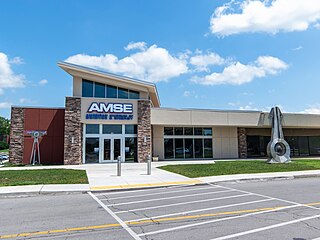
The American Museum of Science and Energy (AMSE) is a science museum in Oak Ridge, Tennessee, designed to teach children and adults about energy, especially nuclear power, and to document the role Oak Ridge played in the Manhattan Project. The museum opened as the American Museum of Atomic Energy in 1949 in an old World War II cafeteria on Jefferson Circle. It moved to its second facility in 1975 and was renamed AMSE in 1978. As of June 2019, the museum is located in the shopping mall across the street from the old location.
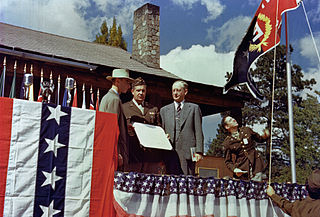
The Manhattan Project was a research and development project that produced the first atomic bombs during World War II. It was led by the United States with the support of the United Kingdom and Canada. From 1942 to 1946, the project was under the direction of Major General Leslie Groves of the US Army Corps of Engineers. The Army component of the project was designated the Manhattan District; "Manhattan" gradually became the codename for the entire project. Along the way, the project absorbed its earlier British counterpart, Tube Alloys. The Manhattan Project began modestly in 1939, but grew to employ more than 130,000 people and cost nearly US$2 billion. Over 90% of the cost was for building factories and producing the fissionable materials, with less than 10% for development and production of the weapons.
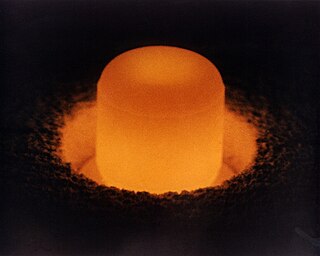
Plutonium-238 is a fissile, radioactive isotope of plutonium that has a half-life of 87.7 years.
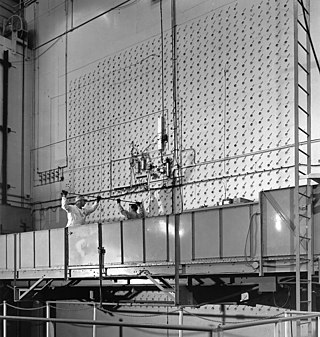
The X-10 Graphite Reactor is a decommissioned nuclear reactor at Oak Ridge National Laboratory in Oak Ridge, Tennessee. Formerly known as the Clinton Pile and X-10 Pile, it was the world's second artificial nuclear reactor, and the first designed and built for continuous operation. It was built during World War II as part of the Manhattan Project.
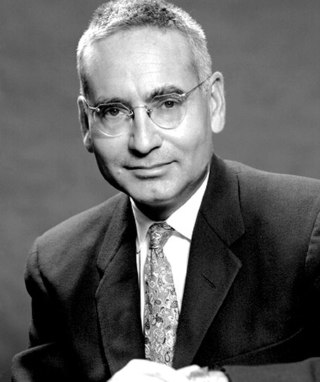
Alvin Martin Weinberg was an American nuclear physicist who was the administrator of Oak Ridge National Laboratory (ORNL) during and after the Manhattan Project. He came to Oak Ridge, Tennessee, in 1945 and remained there until his death in 2006. He was the first to use the term "Faustian bargain" to describe nuclear energy.

Atomic tourism or nuclear tourism is a recent form of tourism in which visitors learn about the Atomic Age by traveling to significant sites in atomic history such as nuclear test reactors, museums with nuclear weapon artifacts, delivery vehicles, sites where atomic weapons were detonated, and nuclear power plants.
The Atomic Heritage Foundation (AHF) is a nonprofit organization originally based in Washington, DC, dedicated to the preservation and interpretation of the Manhattan Project and the Atomic Age and its legacy. Founded by Cynthia Kelly in 2002, the Foundation's stated goal is, "to provide the public not only a better understanding of the past but also a basis for addressing scientific, technical, political, social and ethical issues of the 21st century." AHF works with Congress, the Department of Energy, the National Park Service, state and local governments, nonprofit organizations and the former Manhattan Project communities to preserve and interpret historic sites and develop useful and accessible educational materials for veterans, teachers, and the general public. In June 2019, the Atomic Heritage Foundation and the National Museum of Nuclear Science & History signed an agreement that granted stewardship of the Atomic Heritage Foundation website and all of the AHF's physical collections to the museum. The Atomic Heritage Foundation website is now run by the National Museum of Nuclear Science & History. Additionally, the museum now houses the Atomic Heritage Foundation's physical collections which will eventually be integrated into the Nuclear Museum's own collection.

The Dayton Project was a research and development project to produce polonium during World War II, as part of the larger Manhattan Project to build the first atomic bombs. Work took place at several sites in and around Dayton, Ohio. Those working on the project were ultimately responsible for creating the polonium-based modulated neutron initiators which were used to begin the chain reactions in the atomic bombs.

Franklin Thompson Matthias was an American civil engineer who directed the construction of the Hanford nuclear site, a key facility of the Manhattan Project during World War II.
The RaLa Experiment, or RaLa, was a series of tests during and after the Manhattan Project designed to study the behavior of converging shock waves to achieve the spherical implosion necessary for compression of the plutonium pit of the nuclear weapon. The experiment used significant amounts of a short-lived radioisotope lanthanum-140, a potent source of gamma radiation; the RaLa is a contraction of Radioactive Lanthanum. The method was proposed by Robert Serber and developed by a team led by the Italian experimental physicist Bruno Rossi.

James Edward Westcott was an American photographer who was noted for his work with the United States government in Oak Ridge, Tennessee, during the Manhattan Project and the Cold War.

The Clinton Engineer Works (CEW) was the production installation of the Manhattan Project that during World War II produced the enriched uranium used in the 1945 bombing of Hiroshima, as well as the first examples of reactor-produced plutonium. It consisted of production facilities arranged at three major sites, various utilities including a power plant, and the town of Oak Ridge. It was in East Tennessee, about 18 miles (29 km) west of Knoxville, and was named after the town of Clinton, eight miles (13 km) to the north. The production facilities were mainly in Roane County, and the northern part of the site was in Anderson County. The Manhattan District Engineer, Kenneth Nichols, moved the Manhattan District headquarters from Manhattan to Oak Ridge in August 1943. During the war, Clinton's advanced research was managed for the government by the University of Chicago.
African-American scientists and technicians on the Manhattan Project held a small number of positions among the several hundred scientists and technicians involved. Nonetheless, African-American men and women made important contributions to the Manhattan Project during World War II. At the time, their work was shrouded in secrecy, intentionally compartmentalized and decontextualized so that almost no one knew the purpose or intended use of what they were doing.

The Hanford Engineer Works was a nuclear production complex established by the United States federal government in 1943 as part of the Manhattan Project during World War II. The site, located at the Hanford Site on the Columbia River in Benton County, Washington, was home to the B Reactor, the first full-scale plutonium production reactor. Plutonium manufactured at the site was used in the first atomic bomb in the Trinity test, and in the Fat Man bomb that was used in the atomic bombing of Nagasaki in August 1945. It was commanded by Colonel Franklin T. Matthias until January 1946, and then by Colonel Frederick J. Clarke.





















